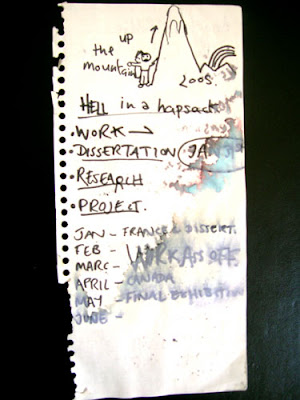Hell in a Napsack?

On my way into town this morning, something caught my eye—the note you see posted above was just lying on the street. Here is my interpretation of this wonderful specimen: a small piece of water-damaged graph paper torn from a spiral bound notebook. Measuring approximately 2.5 x 5 inches, the paper seems to derive from a pad most likely used for grocery, "to do" or other lists—notes, in other words, made for the reference of the writer him or herself. What else can we learn about this writer? From the small, schematic self-portrait above, we might be tempted to see the sharp protuberance arching over the figure's right shoulder as a scrunchie-bound length of hair, perhaps indicating that the writer/artist is a she. Well, however we may wish to decide this, he or she was clearly using a water-based pen, which has begun to run to a greenish or even cerulean blue in the right center of the page.

But what does the text actually say? First of all, we have the aforementioned self-portrait of the writer standing next to a steep, snow-capped peak. But, on the far side of the mountain lies a valley and an arching rainbow. As the text explains, "up the mountain ... 2005." Presumably, that is, after enduring "hell in a napsack," the writer will—at some point in 2005—be "golden," having reached the end of the rainbow. But what does this "hell in a napsack" (or perhaps "hapsack") entail? The list of tasks to be completed is as follows:
—Work
—Dissertation (Jan. 31st [presumably, 2005])
—Research
—Project
Jan: France and dissert.
Feb: WORK ASS OFF
March: " " "
April: Canada
May: Final Exhibition
June:
Old Ken has heard that Canada is a central location for cosmetic surgeries of various kinds. So presumably after this mountain climber has removed the tissue of her buttocks through the chafing resulting from an arduous climb up an icey peak wearing a "hellish" backpack, she plans to repair to Canada for some skin grafts. Could this be the eagerly-awaited pot of gold at the end of the rainbow? Or will the ultimate, promised "exhibition" be the occasion to display the mysteries of the surgeon's knife? More to follow ...
Labels: Found




















